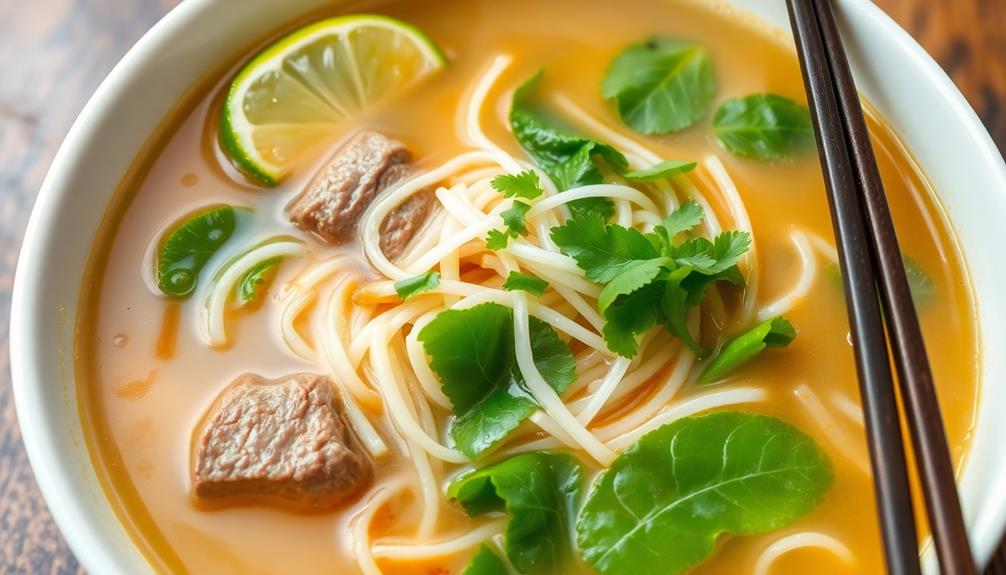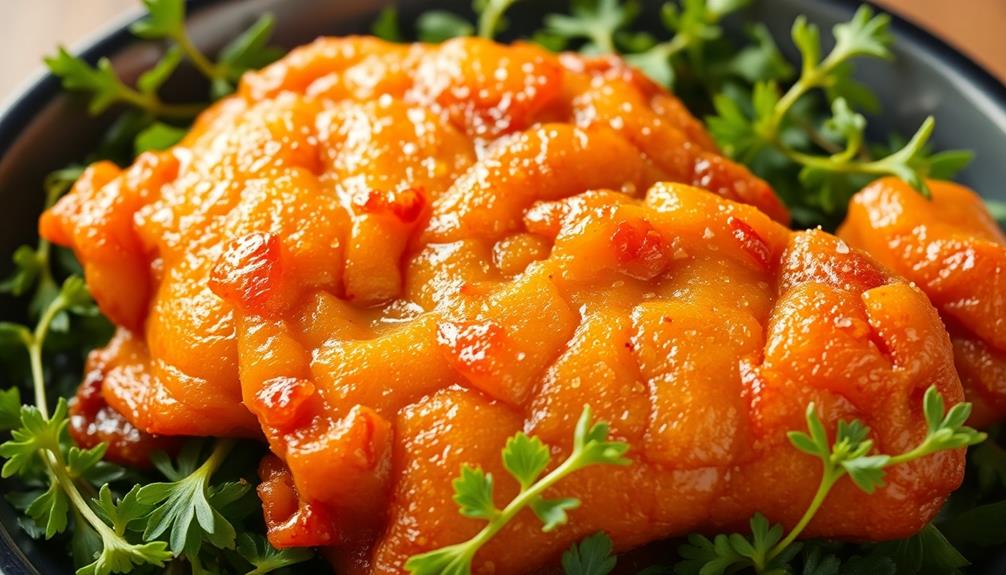Noodle soup is a timeless dish that's comforted taste buds for generations. Originating in ancient China, these savory soups feature an array of regional specialties, from the bold Tom Yum Goong in Thailand to the aromatic Pho in Vietnam. You'll find rice, wheat, or buckwheat noodles swimming in rich broths made by simmering proteins and veggies. While the base is classic, you can customize each bowl with garnishes like crispy onions or chili oil. Whether you're craving a warming meal on a chilly day or a light, refreshing option, noodle soup offers endless possibilities to please your palate. Let's explore more about the history and recipes behind this beloved dish.
Key Takeaways
- Noodle soup has ancient origins in China, with regional variations reflecting local culinary traditions and ingredients.
- Noodle soups offer versatility, allowing for customization with different broths, proteins, and vegetables.
- The key to a delicious noodle soup is a rich, flavorful broth created through extended simmering.
- Preparation steps involve soaking noodles, prepping aromatics, and assembling the soup with cooked meats or seafood.
- Noodle soup is a comforting and satisfying dish that can be enjoyed year-round.
History
Noodle soup's origins can be traced back to ancient China, where it was a staple dish enjoyed by commoners and emperors alike. Over the centuries, noodle soup recipes evolved, reflecting the culinary traditions and local ingredients of various regions.
In China, you might find noodles made from rice, wheat, or buckwheat, while the broth could be chicken, beef, or even seafood-based.
As noodle soup spread to other parts of Asia, it took on distinct regional flavors. In Thailand, you'd savor the tangy, spicy Tom Yum Goong, while in Vietnam, the classic Pho features tender beef, fragrant herbs, and a rich, simmered broth.
Japanese ramen, with its chewy noodles and umami-packed toppings, has also become a global sensation.
Noodle soup's enduring popularity speaks to its versatility and comforting qualities. Whether it's a steaming bowl on a chilly day or a refreshing meal on a hot afternoon, this humble dish continues to delight and nourish people around the world.
Recipe
Noodle soup is a comforting and versatile dish that can be enjoyed year-round. This recipe features a rich, flavorful broth and a variety of noodles and vegetables for a satisfying meal.
The key to a delicious noodle soup is the broth. By simmering the broth for an extended period, you can extract maximum flavor from the ingredients, creating a deep, complex base for the soup. The noodles and vegetables can then be added to the broth, allowing them to absorb the wonderful flavors.
- Chicken or vegetable broth
- Rice noodles or udon noodles
- Sliced chicken or tofu
- Mushrooms
- Carrots
- Bok choy or spinach
- Green onions
- Soy sauce
- Sesame oil
- Fresh ginger
- Garlic
Begin by bringing the broth to a simmer in a large pot. Add the sliced chicken or tofu, mushrooms, carrots, and bok choy or spinach. Simmer for 15-20 minutes, allowing the flavors to meld.
Add the noodles and cook for an additional 5-10 minutes, or until the noodles are tender. Season with soy sauce, sesame oil, fresh ginger, and garlic to taste.
To enhance the flavor and provide a textural contrast, consider garnishing the noodle soup with crispy fried onions, toasted sesame seeds, or a drizzle of chili oil. Enjoy this comforting and satisfying noodle soup any time you need a warm, flavorful meal.
Cooking Steps
First, soak the rice noodles in hot water until they're pliable.
Next, prepare your veggies and aromatic ingredients like garlic and ginger.
Then, bring your broth to a boil and add any cooked meat or seafood you want.
Step 1. Soak Rice Noodles in Hot Water
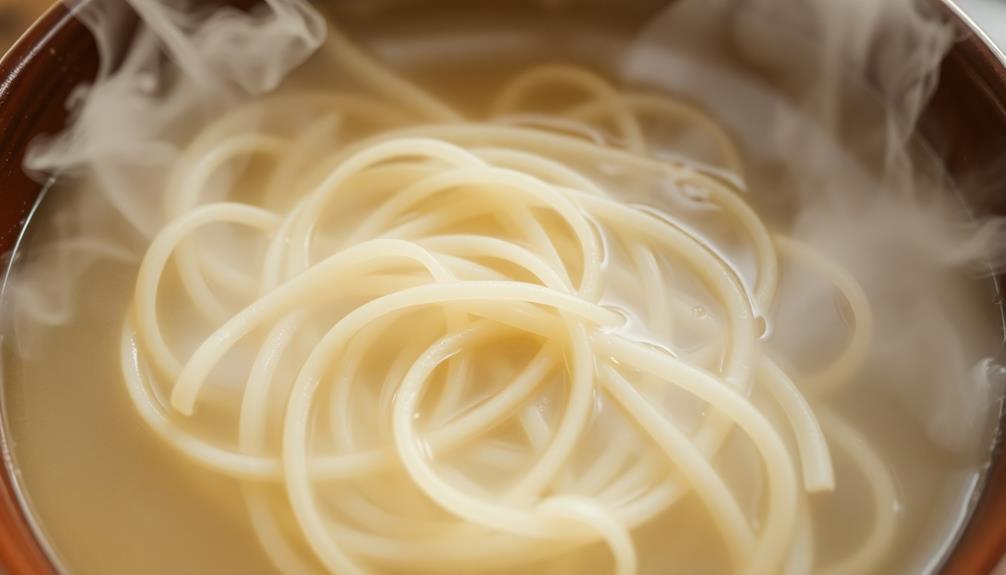
To prepare the rice noodles, let the noodles soak in a bowl of hot water for about 15 to 20 minutes. This softens the noodles and makes them pliable, ready to be added to the soup.
Be sure the water is hot, not boiling, as that could damage the delicate rice noodles. After soaking, drain the noodles and rinse them briefly under cool water to stop the cooking process.
Now the noodles are prepped and ready to be added to the flavorful broth. The soaking step is crucial, as unsoaked noodles will be too firm and won't blend well with the soup.
With the noodles softened, they'll easily absorb the aromatic broth, creating the perfect texture and flavor combination. This simple step sets the stage for a satisfying, nourishing bowl of kuay tiew. Once the broth has been fully absorbed, the noodles are ready to be paired with the tender slices of chicken, fresh herbs, and a squeeze of lime. This delicious recipe for kuay tiew kua gai is a classic Thai dish that highlights the balance of sweet, salty, spicy, and sour flavors. With each bite, you’ll experience the rich, complex layers of this beloved street food.
Step 2. Prepare Vegetables and Aromatics
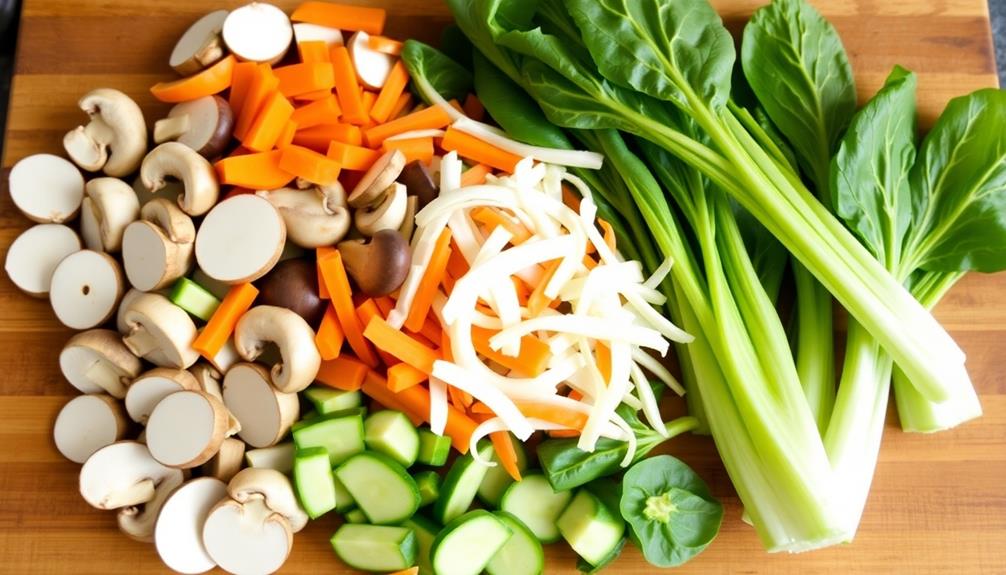
With the noodles softened and ready, you can now turn your attention to preparing the vegetables and aromatics that will infuse the broth with flavor.
Start by chopping up fresh herbs like cilantro, basil, and mint. These will provide a bright, aromatic garnish for the finished soup.
Next, slice up some crisp veggies like carrots, bean sprouts, and scallions. Their crunchy texture and subtle flavors will lend balance to the dish.
Don't forget the aromatics – you'll want to mince a few cloves of garlic and a thumb-sized piece of ginger. These powerhouse ingredients will give the broth a fragrant, warming base.
Finally, thinly slice a chili pepper if you'd like to add a bit of heat.
Have all your prepared ingredients ready to go so you can quickly assemble the soup when the time comes.
With the noodles, veggies, and aromatics prepped, you're well on your way to a flavorful, satisfying bowl of noodle soup.
Step 3. Bring Broth to a Boil
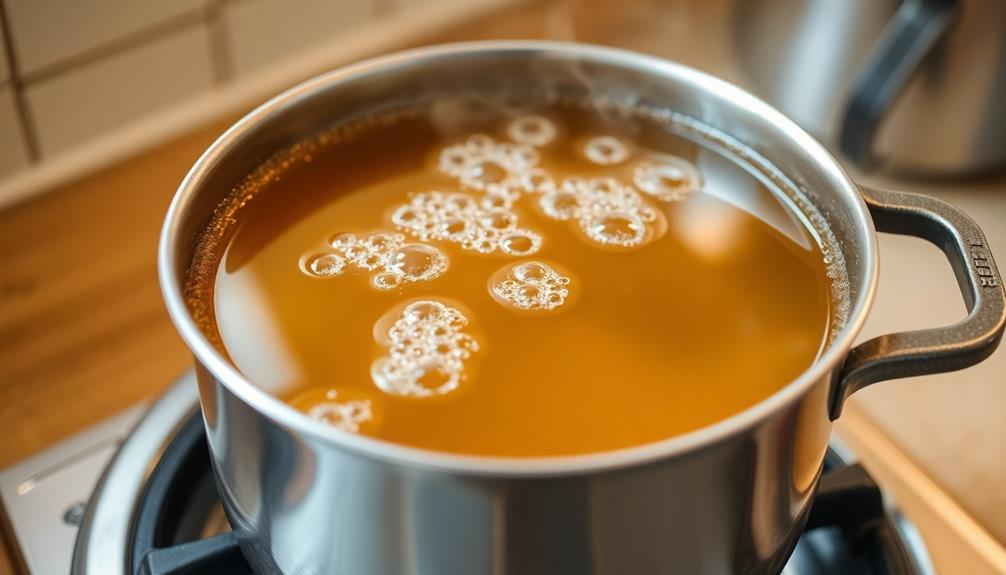
Now, bring a large pot of flavorful broth to a gentle boil over medium-high heat.
You'll want to keep a close eye on the pot, adjusting the heat as needed to maintain a steady simmer. As the broth heats up, you might notice some small bubbles forming on the surface, slowly building in size and frequency. This is a good sign – it means the broth is coming to life and ready for the next steps.
Once the broth is gently boiling, you can reduce the heat to medium-low to keep it at a steady simmer. This gentle, rolling boil is perfect for infusing the noodles and other ingredients with all the delicious flavors.
Be careful not to let the broth come to a rapid, rolling boil, as that could result in overcooking or even evaporation of the precious liquid.
With the broth simmering away, you're now ready to add the noodles and finish assembling your tasty Kuay Tiew.
Step 4. Add Cooked Meat or Seafood
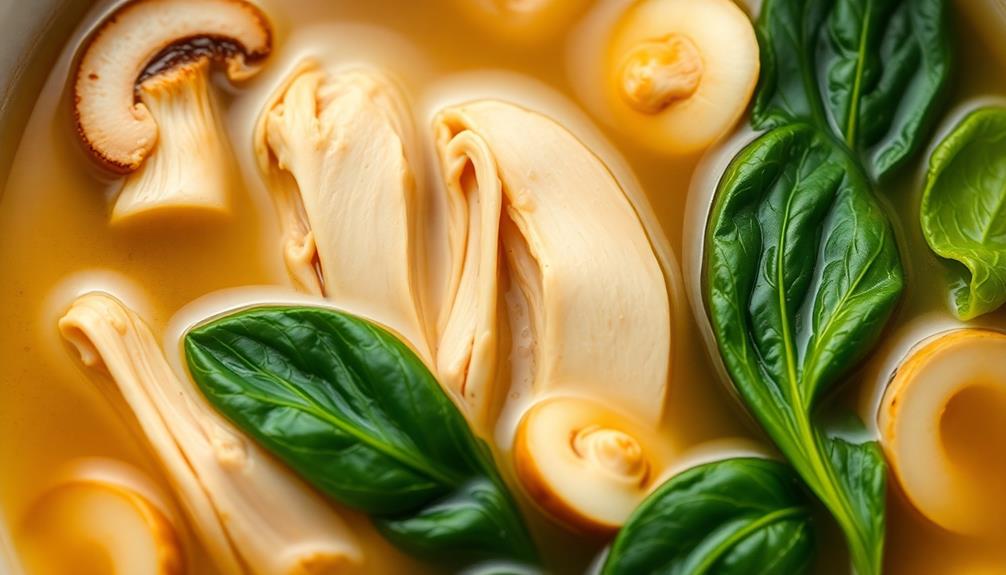
Once the broth is simmering, you can begin adding any cooked meat or seafood you'd like to include. This is a great way to turn your noodle soup into a heartier, more satisfying meal.
Thinly sliced cooked chicken, beef, or pork work wonderfully, as do shrimp, scallops, or sliced fish fillets. Just be sure the protein is already fully cooked before adding it to the hot broth – this will simply warm it through and allow the flavors to meld.
You can add the cooked meat or seafood directly to the individual serving bowls, or you can mix it right into the large pot of broth.
Either way, stir it in gently and allow it to heat through for a minute or two before ladling the soup into bowls. This extra protein will make your noodle soup even more nourishing and delicious.
Feel free to get creative with the type of meat or seafood you use, based on your personal preferences and what you have on hand.
Step 5. Assemble and Serve Immediately
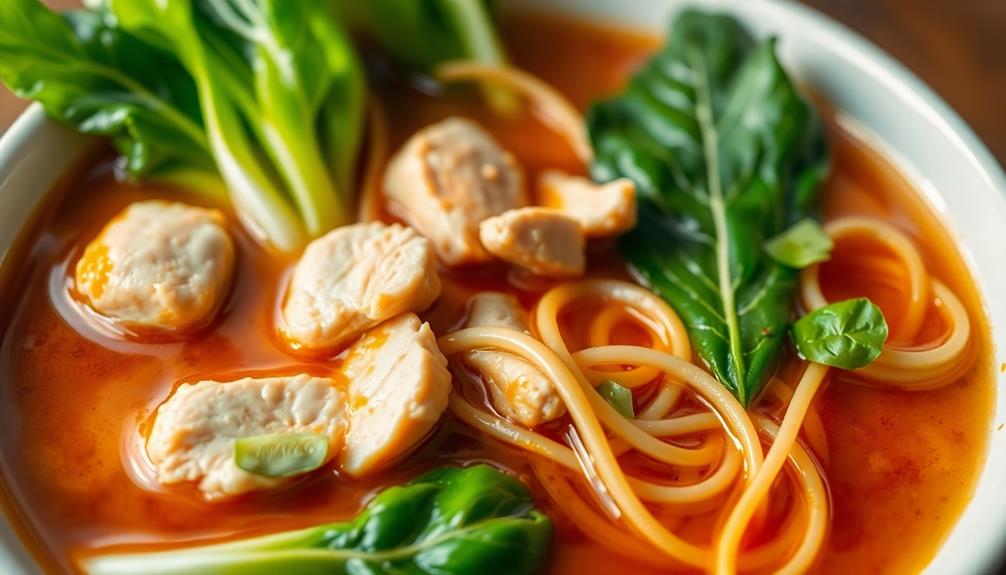
Assembling and serving the noodle soup immediately is key to enjoying its full flavor and texture. First, divide the cooked noodles evenly among serving bowls. Ladle the hot broth over the noodles, ensuring each bowl is filled to the brim.
Next, arrange the cooked meat or seafood on top of the noodles, allowing the hot broth to warm it through. Sprinkle the fresh garnishes like cilantro, green onions, and lime wedges over the top. This final touch adds a vibrant pop of color and freshness to the dish.
Serve the noodle soup piping hot, encouraging your guests to dig in right away. The warmth of the broth, the chewiness of the noodles, and the tender proteins create a harmonious blend of flavors and textures.
Slurp up the soup, using chopsticks to gather the noodles and ingredients in each bite. Squeeze a wedge of lime over the top to brighten the flavors before enjoying every last sip.
Final Thoughts
Ultimately, noodle soup remains a timeless and comforting dish that transcends cultures and generations.
Whether you're craving a quick weeknight meal or seeking a soothing respite on a chilly day, this versatile soup offers endless possibilities.
Don't be afraid to experiment and customize your noodle soup to suit your personal preferences.
Try different broths, proteins, and vegetables to discover new flavor combinations that delight your palate.
Frequently Asked Questions
How Long Does It Take to Prepare Kuay Tiew?
Preparing this dish doesn't take too long. You can have it ready in about 20-30 minutes, depending on your cooking skills and the ingredients you're using. Just follow the recipe and you'll have a tasty meal in no time.
Can Kuay Tiew Be Made Vegetarian or Vegan?
Absolutely! You can easily make kuay tiew vegetarian or vegan by omitting the meat and using vegetable broth instead of chicken or beef stock. Get creative with your veggie fillings for a delicious meatless meal.
What Are the Best Substitutes for Traditional Kuay Tiew Ingredients?
To make a vegetarian or vegan version, you can substitute traditional ingredients with tofu, mushrooms, leafy greens, and vegetable broth. Get creative with plant-based proteins and flavorful vegetables to craft a delicious meatless dish.
How Can I Adjust the Spice Level in Kuay Tiew?
To adjust the spice level in your dish, start by adding a small amount of your desired chili pepper or spice blend. Taste as you go and gradually increase the amount until you reach your preferred level of heat.
Is Kuay Tiew Gluten-Free?
Typically, kuay tiew is not gluten-free as it contains wheat-based noodles. However, you can find gluten-free versions made with rice or other gluten-free flours. Be sure to check the ingredients carefully when ordering or making kuay tiew.
